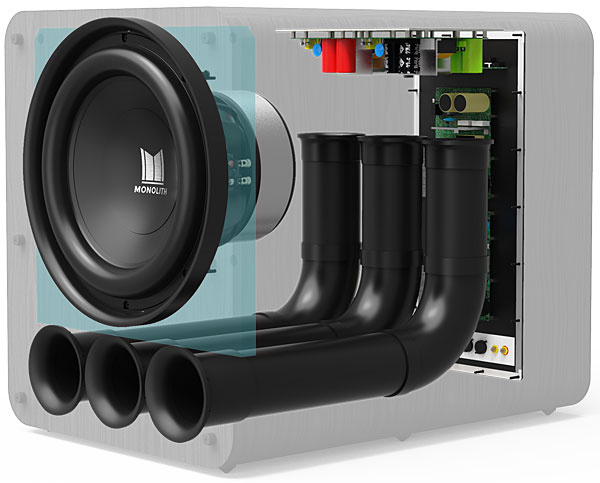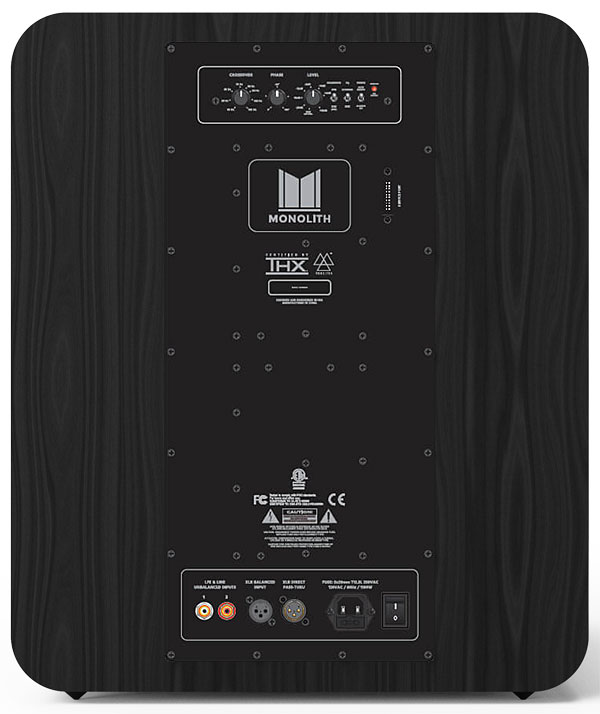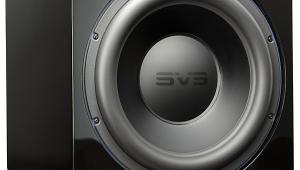a rebranded SVS?
Monolith by Monoprice 13-Inch THX Ultra Certified Subwoofer Review

AT A GLANCE
Plus
Reference-level extension and output
Exceptionally flat, controlled response through crossover octaves
THX Ultra Certified
Minus
No auto-EQ/correction or remote control
Very big and heavy
No pass-through outputs
THE VERDICT
Monolith by Monoprice's 13THX is huge, heavy, and lacks the convenience of app-controlled on-board automated EQ and curve-selection. But if you have more-than-generous space and budget, it's all the subwoofer you or anyone else will ever need.
Got bass? I do. Boy, do I ever: Monolith by Monoprice's newest THX Ultra Certified 13-inch behemoth. You might think that a "13-inch" sub would be just a bit bigger than a typical 12-inch job, maybe 15 or 16 inches wide, and perhaps as heavy as 70 or 80 pounds. Think again.
The 13THX (what I'm calling it since Monolith's sub does not appear to have a name per se) is roughly 20 x 24 x 29 inches (WxHxD) and tips the scales at a svelte 153.2 pounds. And that's the "little one." There's also a companion 16THX—yes, with a 16-inch driver—that weighs 176 pounds. The new THX Certified subs, like the rest of the Monolith line of subwoofers, speakers, and components, comes from Monoprice, the direct-marketer that started out with cable and computer accessories but has grown into a giant seller of all things audio and much more.
Subwoofers, like all loudspeakers, are in effect pumps: they don't move air very far, but move it they must in order to induce the airborne vibrations that we hear as sound. The lower the frequency the more the work involved, and much as with piston engines (another sort of pump) there are few substitutes for cubic inches. (Few, but not none: equalization, amplifier power, and extreme driver throw can in combination do the trick, up to a point.)
A bigger diaphragm interfaces with more air molecules, and thus has a huge advantage in efficiency, in the physics sense, over a smaller one. (This should not be confused with loudspeaker sensitivity, even though the two terms are often bandied about interchangeably.) A 13-inch circle has 15 percent more area than a 12-inch one, which suggests why Monoprice bumped its newest Monolith sub up that one mere inch.
Otherwise, the 13-inch transducer developed for the 13THX has all the features you'd want in a sub-purposed cone driver. These include a very long-throw suspension, with an impressive claimed 90mm peak-to-peak; a vented cone and "spider," the first to equalize air pressure on both sides of the diaphragm, enhancing linearity, and the second to help cool the voice-coil, increasing power handling; a purpose-modeled magnet structure incorporating dual aluminum shorting rings (these help focus magnetic flux to increase sensitivity and reduce eddy currents to lessen distortion). It's a massive driver, obviously manufactured with care and weighing some 60 pounds all by its lonesome.

The box is made from HDF—high-density fiberboard—as opposed the to the much more common MDF. According to Monoprice, this in combination with internal bracing yields a stiffer, less resonant enclosure. (And did I mention heavier?) There are three huge ports, flared at both ends to reduce the turbulence that can plague big subs, and these are equipped with equally big foam plugs. The plugs can be retained or removed in any combination, yielding an effective choice of four alignments. (In general, a sealed box rolls off sooner but more gradually, and is usually flatter around the roll-off point.) The on-board amplifier is of course a class-D design, for which Monoprice boasts 2 kilowatts steady-state and 3,800 watts peak. The whole is finished in an undistinguished-but-nice matte black. (Monoprice's webpage lists this as "Black Ash," but there's absolutely no visible woodgrain. Instead, it's a sort of an eggshell finish that I quite liked.) Oh yeah, there's also a "floating" grille, which is a fairly massive thing in itself. I examined it, tried it on, and then put it back in the box.
Setup
I'll spare you the gory details of wrestling the 13THX out of its massive carton and into place, except to say it took three of us, two of whom came through the experience just fine. I located the sub in the usual spot, one long since-established as the optimum floorspace to yield the smoothest—or at least, least-egregiously peaky—response from any subwoofer in my room. This put it alongside the front-right speaker and a few feet out from the wall, where it absolutely dwarfed everything else.

Hookup required just the supplied IEC power cord and the existing long RCA interconnect from my preamp/processor. Monolith's sub includes both balanced XLR and unbalanced RCA stereo inputs (summing, of course, internally), but I stuck with unbalanced. Why? Unless you live in an airport control tower (for radio-frequency rejection), or in an anechoic chamber where you can hear the 2 or 3 dB additional dynamic range it may (repeat: may) deliver, balanced audio connections are just for show.
With no remote control, wireless connectivity, or app-controlled EQ on Monolith's sub, its control panel is surprisingly plain. Three knobs continuously control Level, Crossover (frequency), and Phase, and three switches toggle crossover enable/disable, two EQ options, and auto-on/off power.
- Log in or register to post comments


The control panel of Monolith's sub is shockingly simple, lacking features like a remote control, wifi connectivity, or an app-controlled equalizer.
basketball stars































































